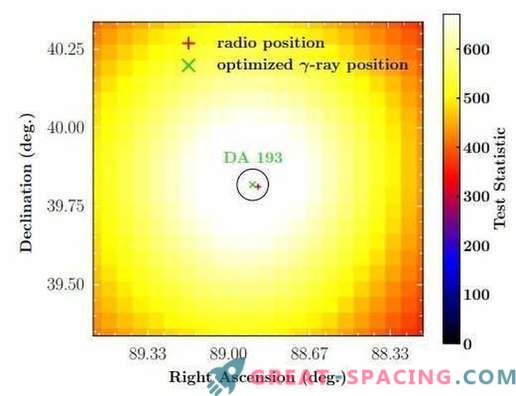
An international group of scientists recorded an intense and incredibly bright gamma flash from a DA 193 blazar with a high redshift. New detection is considered an unusual discovery, since bright flashes are rarely seen from sources with such a large redshift.
Blazars are the most numerous non-galactic sources of gamma rays. Their characteristic features include relativistic jets directed exactly toward the Earth. That is, for astronomers, blazars are high-energy engines that serve as natural laboratories for studying particle acceleration, relativistic plasma processes, magnetic field dynamics, and black hole physics.

The test statistical card DA 193, created over the period MJD 54683−58137. The image scale is 0.05 degrees per pixel, and the black circle marks the positional 95% uncertainty obtained from the Fermi-LAT analysis. Radio and optimized y-ray positions are also shown.
Surveys show that blazars with high redshift (above 2.0) contain massive black holes, and the most powerful relativistic jets are the brightest. Finding and observing new blazars with a high redshift level is crucial for understanding many phenomena in the Universe, including the evolution and bulk density of massive black holes. Recently, scientists have studied the blazar with a high redshift. For this purpose, a LAT instrument was used onboard the NASA Fermi gamma-ray telescope and other instruments. They were needed to compose the DA 193 characteristic — the blazar observed near the galactic antistenter, whose redshift index is 2.36. The observations led to the fixation of remarkable gamma radiation from the object.
The analysis showed that DA 193 suffered a big outbreak in the first week of 2018. Researchers report that this was an extremely bright gamma-flash with a luminosity level of about 120 quindecillion erg / s. This is a rare phenomenon, because usually blazars weakly manifest themselves in the gamma range.
It was also unexpected to find an incredibly strong gamma-ray spectrum. What could have caused such an intense outbreak in DA 193? Astronomers believe that the reason was the change in the behavior of the main electronic population. It is planned to continue using the LAT for further continuous monitoring of the sky for the presence of gamma rays in order to find more powerful blazars with flashes, like that of DA 193.











































